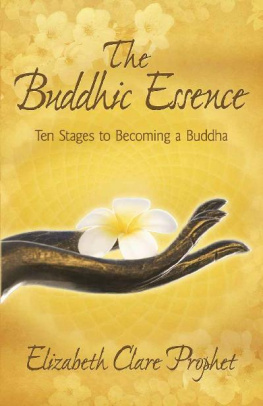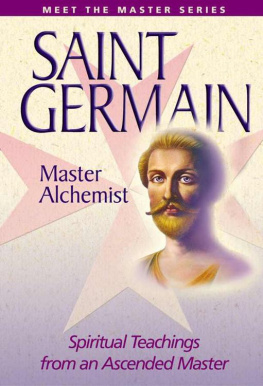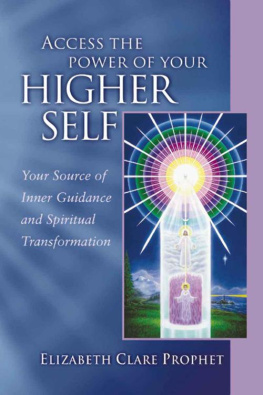M Y S T I C A L P A T H S O F T H E W O R L D S R E L I G I O N S
The Buddhic Essence
Ten Stages to Becoming a Buddha
Elizabeth Clare Prophet

Gardiner, Montana
The Buddhic Essence
Ten Stages to Becoming a Buddha
by Elizabeth Clare Prophet
Copyright 2009 Summit Publications, Inc.
All rights reserved
No part of this book may be reproduced, translated, or used in any format or medium whatsoever without prior written permission, except by a reviewer who may quote brief passages in a review.
For information, contact Summit University Press,
63 Summit Way, Gardiner, MT 59030-9314 USA
Tel: 1-800-245-5445 or 406-848-9500
www.SummitUniversityPress.com
Library of Congress Control Number: 2009925649
ISBN: 978-1-932890-16-7 (paperback)
ISBN: 978-1-932890-36-5 (eBook)
Summit University Press
Cover design by Lynn M. Wilbert
Contents
7 First Bhumi: Pramudita,
Joyful Stage
8 Second Bhumi: Vimala,
Immaculate Stage
9 Third Bhumi: Prabhakari,
Illuminating Stage
10 Fourth Bhumi: Arcismati,
Radiant Stage
11 Fifth Bhumi: Sudurjaya,
Very-Difficult-to-Conquer Stage
12 Sixth Bhumi: Abhimukhi,
Face-to-Face Stage
13 Seventh Bhumi: Duramgama,
Far-Reaching Stage
14 Eighth Bhumi: Acala,
Immovable Stage
15 Ninth Bhumi: Sadhumati,
Good Thoughts Stage
16 Tenth Bhumi: Dharmamegha,
Cloud of the Dharma Stage
Jnana-paramita:
The Perfection of Divine Transcendent Knowledge
17 The Doctrine of the Trikaya
(Three Bodies of the Buddha)
The Incalculable Merit of the Mantra
Om Mani Padme Hum I AM a Being of Violet Fire!
I AM the Purity God Desires!
The Flower Sermon
Gautama Buddha taught not only through discourse and example but also, at times, through symbols and imagery. His Flower Sermon exemplifies the transmission of wisdom through direct experience.
One day on Vulture Peak, while the disciples were seated in rapt attention, the Buddha came before the assembly and silently held up a flower. Only Mahakasyapa (Universal Light Drinker) smiled, indicating his understanding.
Buddha confirmed that a transmission of the Enlightened Mind had taken place without any words being spoken.
Introduction
In this volume, Elizabeth Clare Prophet illumines our pathway to Buddhahood. Drawing upon traditional and modern Buddhist teachings, illustrations and stories, she shows how we can begin tracing the path that leads from where we are today to complete Buddhic enlightenment.
In the first half of the book, Mrs. Prophet lays the foundation for the ten stages of this path. She begins with the premise that we all contain the seed of Buddhahood, called the Buddha-nature. She describes the transcendental force of bodhicitta, the cosmic will for universal salvation, and explains specific devotional practices that cultivate the conditions in which it can arise. Those who vow to attain Buddhahood for the benefit of all life are called bodhisattvas . Mrs. Prophet offers insight into the mind and heart of the bodhisattva and elucidates the nature of vows and their transcendent power to tether the bodhisattva to his goal.
The second half of the book outlines the traditional ten stages of the bodhisattvas path to Buddhahood. Mrs. Prophet describes ten transcendental virtues the aspirant perfects along the way and offers insightful tips for developing them. She defines the three bodies of the Buddha the aspirant to Buddhahood merges with. And in conclusion, she explains how Buddhist mantras help us overcome obstacles to spiritual growth while increasing wisdom, compassion, forgiveness and joy.
A PATH OF WISDOM AND COMPASSION
Gautama Buddhas discourses and dialogues are recorded in the Buddhist sutras (literally threads on which jewels are strung). Some sutras were preached directly by Gautama; others were recited by a disciple either in the Buddhas presence or under his direct inspiration. A few sutras contain the words of transcendent bodhisattvas, beings with the attainment of Buddhahood; these conclude with the Buddhas approval of the teaching they contain. Regardless of the form of delivery, the sutras are all said to emanate from the Enlightened Mind. The sutras, along with the rules of discipline and expository teachings, constitute the wisdom aspect of the Buddhas teachings.
Compassion is another hallmark of Buddhism. Those who observed Gautama Buddhas life spoke of his compassionate behavior and of the practical assistance he gave to so many. His living example of compassion constitutes an equally important aspect of his teaching.
These twin ideals of wisdom and compassion are embodied in the bodhisattva ideal . The bodhisattva strives to attain the wisdom of Buddhahood while compassionately dedicating himself to the salvation of all.
IDEAL ROLE MODELS
Buddhism speaks of earthly bodhisattvas and transcendent (celestial or great) bodhisattvas. Earthly bodhisattvas strive for enlightenment while expressing altruism and compassion for others. Transcendent bodhisattvas have the attainment of a Buddha but have postponed their entry into ultimate nirvana (complete liberation) until all beings realize enlightenment. The great bodhisattvas dwell in the heaven-world, assisting and guiding us toward enlightenment, yet they can assume any physical form they desire in order to offer assistance to life. Their perfect balance of wisdom and compassion makes them ideal role models.
Manjushri is the great Bodhisattva of Wisdom, revered by Buddhists as the patron of arts and sciences and the master of eloquence. In some traditions, Manjushri is said to have become a perfectly enlightened Buddha many aeons ago in another universe. Because wisdom is essential to liberation from suffering, Manjushri is a herald of emancipation.
Kuan Yin, the Bodhisattva of Compassion, is perhaps the most well-known transcendent bodhisattva. She is at times depicted in masculine form and is known by various names, among them Avalokiteshvara and Chenrezi. According to legend, Kuan Yin was about to enter heaven but paused on the threshold as the cries of the world reached her ears. The Kuan Yin Sutra, a chapter of the Lotus Sutra, contains the Buddhas teaching on the Universal Gate of Kuan Yin. In Buddhism, a gate is an entrance to the dharma (the Buddhas teachings), a beginning toward awakening. Kuan Yins universal gate, being immensely wide, can accommodate innumerable beings. Thus, Kuan Yin makes it possible for all to follow the path to Buddhahood.
It is our prayer that Mrs. Prophets presentation of The Buddhic Essence will help you discover your own Buddha-nature and will illumine the path you walk toward enlightenment and Buddhahood.
The Editors
Buddhas and Immortals
A theme in ancient Buddhist literature is the creation of the world by a Mother Goddess, the Eternal Venerable Mother, who sent down to earth ninety-six myriads of her children. They were originally Buddhas and immortals, but once on earth they forgot their true home in paradise.
They grew attached to fame, profit and sensual pleasures. Trapped by these desires, they became enmeshed in samsara (the sea of suffering). And so the Great Law required them to repeatedly die and be reborn that they might recognize the transient nature of their desires.
The Venerable Mother grieved for her lost children and sent down messenger deities to remind them of their true nature and the way back home. These messengers were Buddhas who had passed all the initiations of the bodhisattvas .










